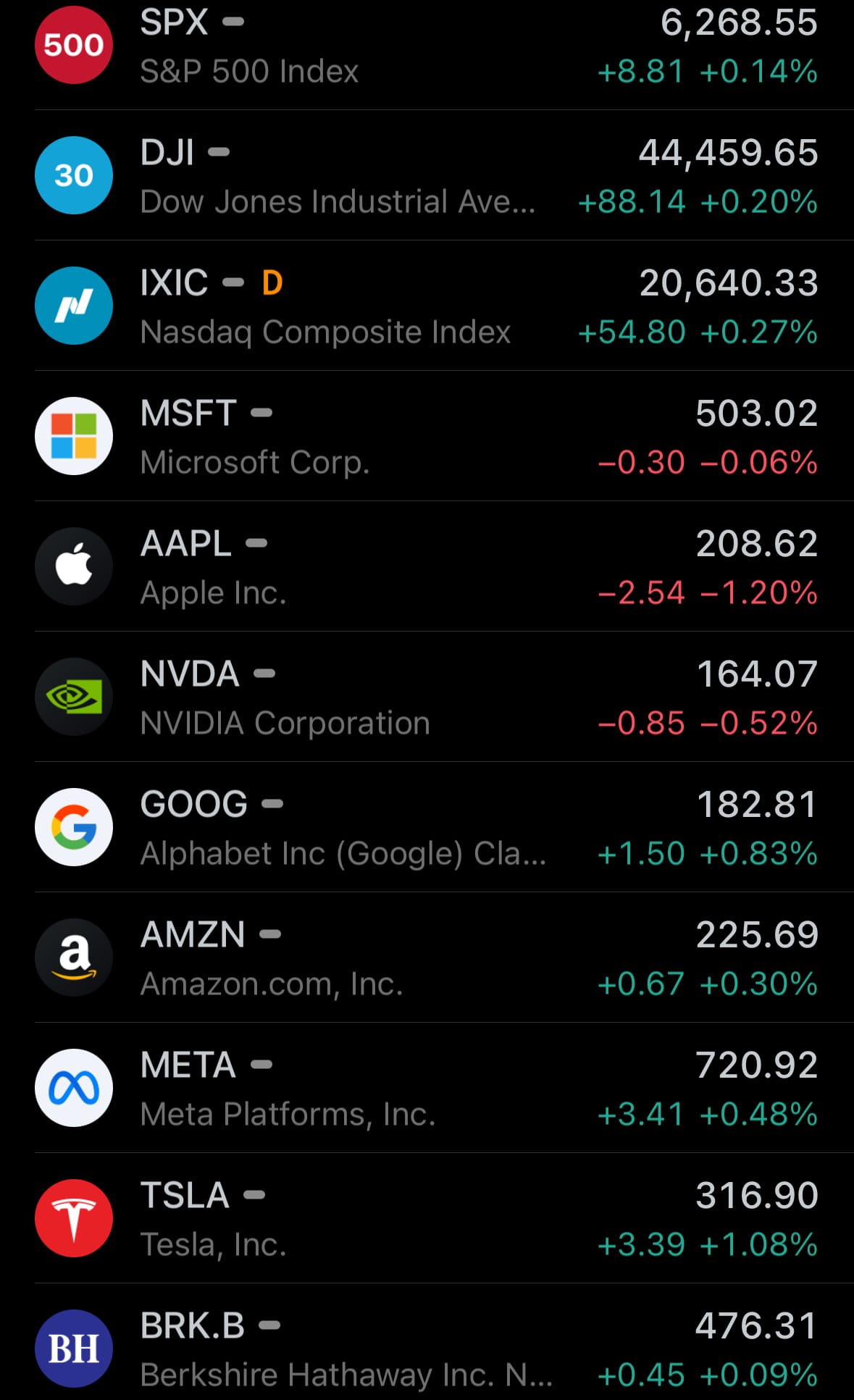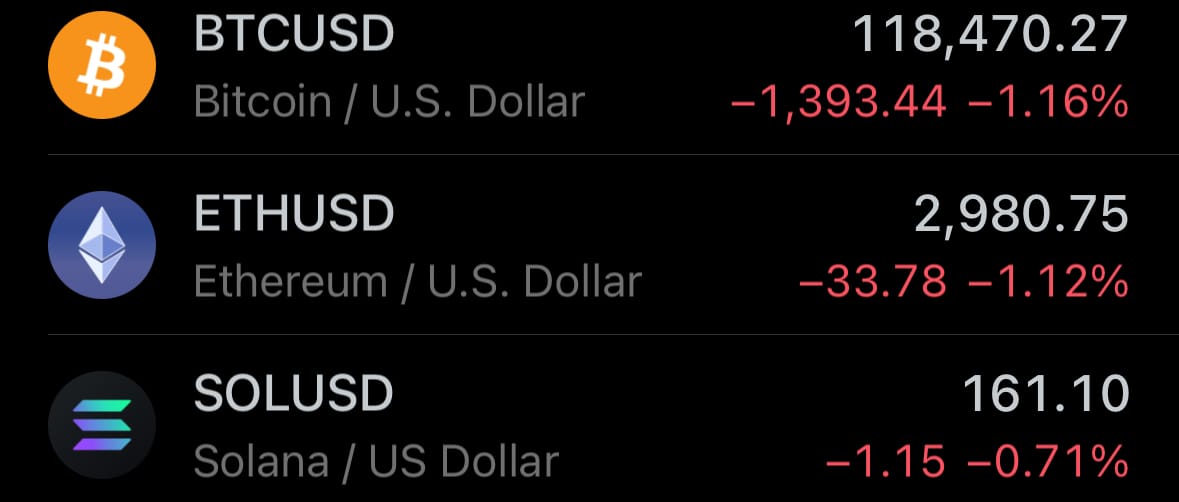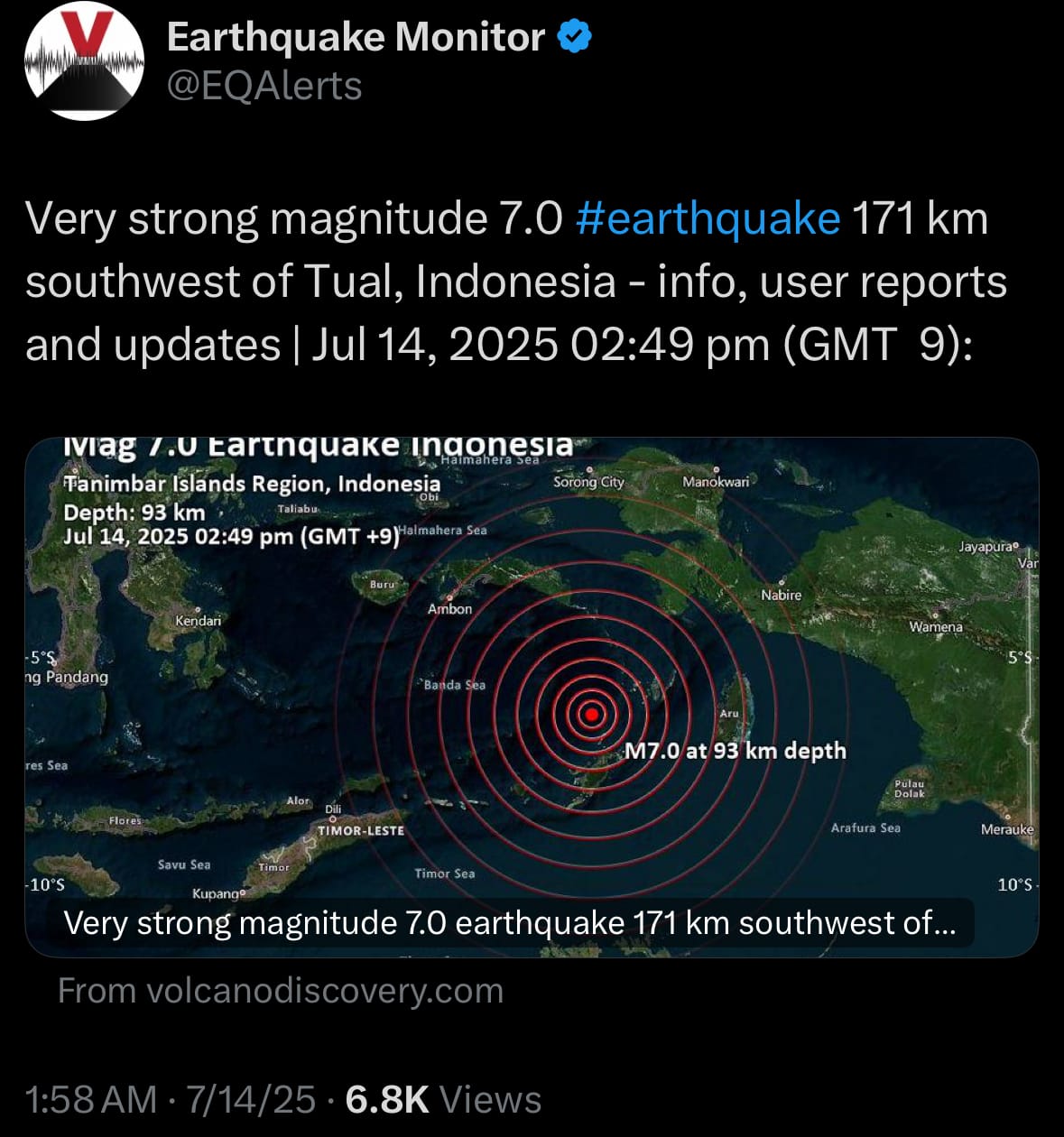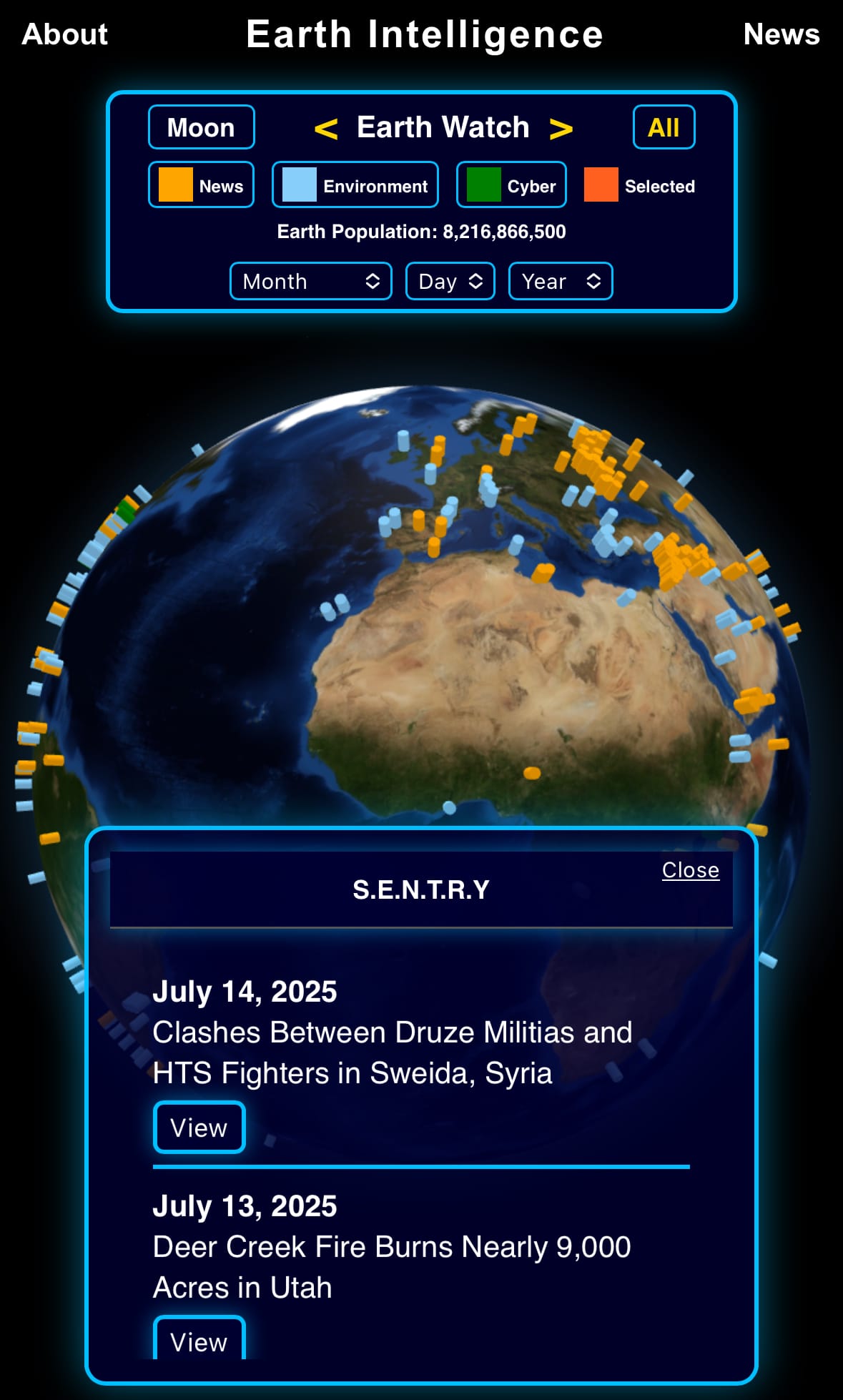Tuesday☕️

Economics & Markets:
- Yesterday’s U.S. stock market:

- Yesterday’s commodity market:

- Yesterday’s crypto market:

Geopolitics & Military Activity:

Environment & Weather:
- On July 14, 2025, at 05:49 UTC (2:49 p.m. GMT+9 local time), a magnitude 6.7 earthquake occurred in the Banda Sea, approximately 171 km southwest of Tual in Indonesia's Maluku province. Initial assessments by agencies like the German Research Centre for Geosciences (GFZ) and Indonesia's BMKG reported it as magnitude 7.0, but the U.S. Geological Survey (USGS) revised it to 6.7 after detailed seismic analysis. The epicenter was at coordinates 6.146°S, 131.213°E, at an intermediate depth of 69 km, which mitigated some surface impact compared to shallower events. This quake took place in the seismically active Tanimbar Islands region along the Pacific Ring of Fire, where Indonesia experiences frequent tectonic activity due to converging plates, averaging over 9,300 earthquakes annually.

- The USGS issued a green alert for low risk of casualties or major damage, with shaking intensity estimated at IV (light) in Tual, affecting around 310,000 people in the vicinity, including lighter tremors felt in areas like Fakfak and parts of northern Australia. BMKG confirmed no tsunami threat due to the quake's depth and fault mechanism. As of the latest reports, no deaths, injuries, or significant structural damage have been confirmed, though vulnerable local buildings could experience minor effects, and aftershock monitoring is ongoing. User reports submitted to USGS and shared on platforms like X described light shaking without major disruption.

Space:
- Today, July 15, 2025, at 5:34 a.m., China successfully launched the Tianzhou-9 cargo spacecraft from the Wenchang Satellite Launch Center on Hainan Island, using a Long March-7 Y10 rocket. The launch was executed by the China Manned Space Agency (CMSA), under the oversight of the state-owned China Aerospace Science and Technology Corporation (CASC), which manages China's crewed space program. Wenchang, operational since 2016 as China's newest and southernmost coastal launch facility, is strategically located near the equator to optimize payload capacity for geostationary and low-Earth orbit missions; it has hosted over 30 launches, primarily for heavy-lift vehicles like the Long March-7 series, including previous Tianzhou resupply flights and Tiangong module deployments. The rocket's ascent was nominal, with no reported anomalies, and the spacecraft separated successfully to pursue its orbital path.
- Tianzhou-9 represents the ninth mission in China's automated cargo spacecraft series, designed to resupply the Tiangong space station, which has been fully operational since 2022 and maintains a continuous human presence in low-Earth orbit at 340-450 km altitude. The spacecraft docked autonomously with Tiangong's Tianhe core module about three hours post-launch, delivering supplies to support the Shenzhou-20 crew and ongoing station operations. Its payload totaled approximately 7,500 kg, a record for the series, comprising consumables like food, water, and clothing; propellant for station refueling; maintenance spare parts; and scientific items including upgraded Feitian extravehicular activity (EVA) suits for spacewalks, experimental materials for microgravity research, and platforms for exposure tests such as lunar soil simulant bricks. The mission, expected to last about nine months before deorbiting, underscores China's shift toward fewer but more efficient resupply flights with enhanced cargo capacity since the upgraded Tianzhou variants began in 2023.
Science & Technology:
- On July 14, 2025, AI research company Anthropic introduced a directory of apps and tools that integrate directly with its AI model, Claude, allowing users to establish connections through a single-click authorization process. This feature expands on integrations initially released in May 2024, which permitted Claude to retrieve data from external services like Jira, Google Workspace, Zapier, and Asana to inform its outputs with relevant context. The directory lists compatible tools including Canva (for design creation), Figma (for design tasks), Linear (for project management), Notion (for note and database handling), and Stripe (for payment processing), among others. It distinguishes between remote connections to cloud-based services and local desktop extensions, using standard authentication methods like OAuth to manage data access securely, though access to remote integrations is limited to paid subscribers while local ones are available to all users. The directory enables Claude to interact with external tools by pulling in live data, automating routine actions, and generating tailored content, effectively integrating the AI into existing workflows without requiring manual data entry or switching between applications.

- These integrations support specific functions, such as querying and summarizing emails or documents in Google Workspace, creating automated task flows in Zapier, producing images or graphics from descriptions in Canva, converting design prototypes to code in Figma, or analyzing transaction data in Stripe. Built on Anthropic's open-source Model Context Protocol (MCP), the system ensures Claude can reference data sources in its responses for verification, but it requires users to grant and monitor permissions to protect privacy. While remote features are restricted to subscription plans like Pro, Team, or Enterprise, local extensions are free, and developers have the option to build custom integrations for unsupported tools.
Statistic:
- Largest semiconductor companies by market capitalization:
- 🇺🇸 NVIDIA: $4.001T
- 🇺🇸 Broadcom: $1.296T
- 🇹🇼 TSMC: $1.186T
- 🇳🇱 ASML: $317.20B
- 🇰🇷 Samsung: $301.27B
- 🇺🇸 AMD: $237.11B
- 🇺🇸 Texas Instruments: $199.90B
- 🇺🇸 QUALCOMM: $169.41B
- 🇺🇸 Applied Materials: $158.17B
- 🇬🇧 Arm Holdings: $153.10B
- 🇰🇷 SK Hynix: $146.07B
- 🇺🇸 Micron Technology: $132.74B
- 🇺🇸 Lam Research: $127.42B
- 🇺🇸 KLA: $121.90B
- 🇺🇸 Analog Devices: $120.81B
- 🇺🇸 Intel: $101.63B
- 🇺🇸 Synopsys: $85.26B
- 🇯🇵 Tokyo Electron: $84.09B
- 🇹🇼 MediaTek: $77.81B
- 🇺🇸 Marvell Technology: $62.51B
- 🇨🇳 SMIC: $59.57B
- 🇯🇵 Advantest: $57.06B
- 🇳🇱 NXP Semiconductors: $56.74B
- 🇩🇪 Infineon: $56.63B
- 🇺🇸 Microchip Technology: $39.96B
- 🇺🇸 Monolithic Power Systems: $34.52B
History:
- NVIDIA Corporation began its journey in April 1993 when three engineers—Jensen Huang, Chris Malachowsky, and Curtis Priem—established the company in Sunnyvale, California. Their initial vision centered on creating specialized graphics processing units (GPUs) tailored for the rapidly growing video game market, which demanded powerful hardware to handle complex visual computations. However, the early years were fraught with setbacks; the company's debut product, the NV1 graphics accelerator launched in 1995, flopped because it didn't align well with emerging industry standards like Microsoft's DirectX software framework. This was compounded by the loss of a major contract with Sega for its Dreamcast console, pushing NVIDIA to the brink of bankruptcy—though a timely $5 million infusion from Sega provided a lifeline. Turning things around, NVIDIA achieved its first major success with the RIVA 128 chip in 1997, which quickly sold over a million units thanks to its superior performance in 3D graphics. This momentum continued with innovations like the RIVA TNT in 1998 and the GeForce 256 in 1999, often credited as the world's first true GPU for its dedicated hardware acceleration of graphics tasks. The company went public that same year, strengthening its financial position, and strategically acquired competitor 3dfx in 2000 to absorb valuable graphics technology and talent. Expanding beyond PCs, NVIDIA ventured into mobile devices with the Tegra processor in 2008 and even portable gaming systems like the Shield in 2013. A pivotal development came in 2006 with the introduction of CUDA, a programming platform that enabled GPUs to perform general-purpose computing, setting the stage for future applications in fields like artificial intelligence.
- Over the following decades, NVIDIA evolved from a graphics specialist into a dominant force in artificial intelligence, high-performance computing, and automotive technologies, adapting to new demands in data-intensive industries. In the 2010s, it enhanced its GeForce lineup with the 10 series in 2016, which improved support for virtual reality and early AI features, followed by the RTX 20 series in 2018 that revolutionized gaming through real-time ray tracing—a technique simulating realistic light behavior for more immersive visuals. The 2020s brought further advancements, such as the Ampere architecture powering the GeForce 30 series for consumers and the A100 accelerator for data centers, optimizing tasks like machine learning training. To bolster its infrastructure capabilities, NVIDIA acquired networking firm Mellanox Technologies in 2019 for about $6.9 billion, enhancing data transfer efficiency in large-scale computing environments. Although a ambitious $40 billion attempt to buy Arm Holdings in 2020 fell through in 2022 amid regulatory concerns over market competition, the company rode the AI surge to unprecedented heights: its market value crossed $1 trillion in 2023, climbed to over $3.3 trillion in June 2024 to briefly become the world's most valuable firm, and hit $4 trillion by July 2025, marking a historic first. This growth wasn't without hurdles, including antitrust investigations, export restrictions to China, and a sharp $600 billion valuation dip in January 2025 due to rising AI competition, but NVIDIA rebounded strongly. Recent highlights include the Blackwell chip architecture unveiled in 2024 for advanced AI processing, the release of the NVLM 1.0 AI model in October 2024 to compete in multimodal intelligence, and the July 2025 purchase of AI startup CentML for more than $400 million to refine software optimization for its hardware.
Image of the day:

Thanks for reading!
Earth is complicated, we make it simple.
Click image to view the Earth Intelligence System:



Support/Suggestions Email:
earthintelligence@earthintel.news




